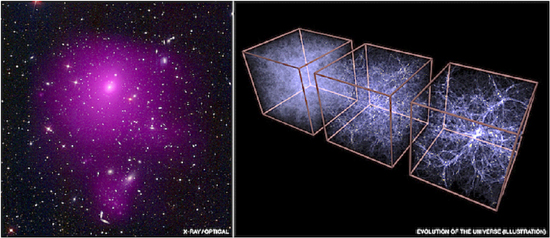
(L) Galactic cluster Abell 85. (R) A simulation of the Universe at 0.9 billion, 3.2 billion and 13.7 billion years. Credit: X-ray (NASA/CXC/SAO/A.Vikhlinin et al.); Optical (SDSS); Illustration (MPE/V.Springel)
Jun 17, 2014
Observations better fit the Electric Universe theory.
In previous Thunderbolts Picture of the Day articles about the existence of “dark matter” it was noted that it is primarily an add-on, or ad-hoc theory, so that the current gravitational model of the Universe can be preserved.
The lack of matter that can be observed in the Universe has always presented a problem to the underlying concept of “big bang cosmology”. According to conventional theories, it was the big bang that brought all matter and energy—including gravity—into existence. Every modern cosmological theory starts with the theory at its core.
According to conventional physics, without adding dark matter to the equation there is not enough gravity in the Universe to account for galaxies bunching together. Also, without sufficient mass, the galaxy clusters should have slowed down considerably over the last few billion years and not maintained such wild recessional velocities, some of which approach 90% the speed of light. In fact, much to the perplexity of standard gravity-only views of the Universe, the more remote galaxies look like they are accelerating away from the Milky Way.
Astronomers first postulated a dark—or cold or exotic—form of matter when they noticed the stars at the edge of a spiral galaxy revolving at the same angular speed as stars closer to the center. However, Newtonian mechanics states that stars farther away from the center should be moving more slowly. Therefore, astronomers assumed dark matter, not observable by current instruments, was imparting extra speed to the stars.
Investigators have also tried for years to reconcile the amount of mass in the Universe with how fast the Universe is expanding. Their only recourse has been to invent the existence of another undetectable force, “dark energy”.
However, Saul Perlmutter, leader of the Supernova Cosmology Project at Berkeley Laboratory has said: “The Universe is made mostly of dark matter and dark energy and we don’t know what either of them is.”
In other words, two of the most actively pursued problems in physics could be based in erroneous ideas about how the Universe is made, and how it should behave within the confines of those ideas. Even conventional theorists do not agree with one another about dark matter and dark energy.
For example, if the Universe is based on the prevailing theories of Einstein and gravity is the bending of time and space around any object with mass, then dark matter and dark energy are merely illusions. The misunderstanding of Einstein’s space/time curvature has necessitated the creation of a new effect because the application of the theory is incorrect. That idea was first suggested in 2006 by a team of Italian researchers who analyzed rotational curves from several galaxies and thought that dark matter and dark energy were not necessary with their new approach.
Even so, there is no need to resort to a super-application of Relativity Theory. Perhaps the theoreticians should look to a science that is basic and foundational rather than inventing brand new sciences and arguing about which is more feasible.
From the perspective of the Electric Universe theory, electric currents drive the galaxies and their associated stars. It has been demonstrated in laboratory experiments that twin Birkeland current filaments can create structures that resemble spiral galaxies. Birkeland currents have a longer-range attractive force than gravity—diminishing with the reciprocal of the distance from the current axis—which could account for the anomalous movement of stars as they revolve around the galactic core.
So, it is the movement of electricity through plasma that tends to initiate the effects that can be observed with space-based telescopes. It is electric currents in the cosmos and their associated magnetic fields that should be the focus of research and not a search for the undetectable.
Stephen Smith
Click here for a Spanish translation












